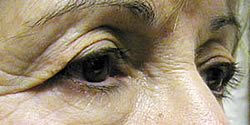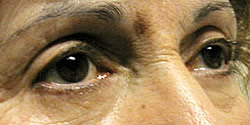Eyelid Surgery in Beverly Hills, CA
Your eyes are the first place to show the inevitable signs of middle age. This is because as your skin ages, the upper lids loose elasticity, start to droop, and create a “puffy” look. In some instances, lids can droop so far, they impair vision. In the lower eyelid, creating a tired look, even if the person feels perfectly fine.
Advances in eyelid surgery have made blepharoplasty the most satisfying plastic surgical procedure among men and women. Blepharoplasty is performed under local anesthesia with sedation in a pleasant outpatient setting. A sutureless self-healing technique is often used.
Dr. Feinfield’s expertise as a Board Certified Ophthalmologist, specializing in eyelid surgery has made him the surgeon of choice for many, including doctors and their families.
Dr. Feinfield is known for his technique in rejuvenating the eyelids to a more natural appearance, tailoring each procedure to the individual. Dr. Feinfield welcomes the opportunity to discuss with you which procedures are best suited for our specific needs.
Blepharoplasty
During your outpatient blepharoplasty, your doctor will administer anesthesia, create small incisions in the natural folds of the eye, and firm up the eyelid skin by extracting excess fat and skin tissue. Finally, the muscle tissue is tightened and the incisions sites are stitched.
Following surgery, you will be given a prescription for any pain and asked to return in a few days for a follow-up examination and removal of your stitches. Follow your doctor’s post-op instructions carefully and you should be back to work in 7 – 10 days and enjoying your rejuvenated look!
Blepharoplasty Before & After Photos
Take a look at how effective eyelid surgery can be! Berg·Feinfield Vision Correction has helped hundreds of Los Angeles men and women rejuvenate their appearances with this safe cosmetic procedure:

Before Blepharoplasty

After Blepharoplasty
Eyelid Surgery FAQ’s
Would I be a candidate for blepharoplasty?
Possibly, if you’re in general good health, and you do NOT have:
- Thyroid disease
- High blood pressure
- Dry eyes
You’d have to understand what blepharoplasty can and cannot do, and we’d cover all that during your initial consultation. For instance, it cannot:
- Remove dark circles under your eyes (unless they’re connected to large bags, in which case the darkness can be lightened but not necessarily eliminated)
- Remove crow’s feet
- Replace skin elasticity lost to sun damage or age
Will there be scars around my eyes?
Any time there’s an incision, there’ll be a scar. The question is: how visible will the scars be? For blepharoplasty, they’ll be hardly visible at all when they’ve finished healing.
Incisions will be placed in the natural creases and folds of the upper and lower eyelids. If you’re having fat removed from the lower eyelids, they can be placed inside the lower lid, so the scar will not be visible.
What sort of anesthesia is used?
Usually, there’ll be a local anesthetic along with some intravenous sedation to help you stay calm and relaxed.
How long do the results last?
If you have fat removed from around your eyes, it won’t return. Some procedures, such as lifting droopy upper lids, may include removing excess skin and tightening muscles as well as removing fat.
But those fat cells are gone forever, and since most blepharoplasty does include some fat removal, that makes most results very long-lasting.
What's the recovery period like?
You can return to work after 2 or 3 weeks. In that period:
- There’ll be some bruising and swelling and you can use ice to help relieve it (always wrap the ice in something). The swelling could last even a month or 6 weeks, probably in the lower lids and on the cheeks.
- The stitches will dissolve (sometimes they have to be removed by your surgeon).
- There may be some paper tape or steri-strips over some areas; don’t remove it.
- Keep your head elevated when you sleep and don’t put any pressure on the treated areas.
- Blurred or double vision may linger for a few days.
- Short walks are a good idea after several days, to encourage good circulation.
- Some people experience some dryness of the eyes. If you use contact lenses this could interfere with resuming their use. Normally you can put them back in after about 5 days.
What are the main risks of eyelid surgery?
Usually, any complications after eyelid surgery are rare:
- Slight asymmetry in scarring
- Some trouble with closing your eyes when you sleep (very rarely permanent)
- Bleeding may continue after the surgery’s over. This would be worst if it occurred at the back of the eye socket. Severe bleeding here can put pressure on the optic nerve and cause permanent vision damage. Such bleeding can be treated however, by opening the blepharoplasty incisions, and by some medications to reduce the pressure in the eye.
Can I have blepharoplasty done along with other procedures?
Yes, that’s a popular way to do it. It’s often done along with:
- Facelifts
- Forehead lifts
- Laser skin resurfacing
Don’t settle for mediocre LASIK. Trust your eyes to the LASIK leaders with a commitment to technology. Contact Berg·Feinfield Vision Correction today for your personal and complimentary eye care consultation.
Look as young as you feel with cosmetic eye procedures from Berg·Feinfield Vision Correction. Call or email us today for your complimentary cosmetic eye care consultation.










